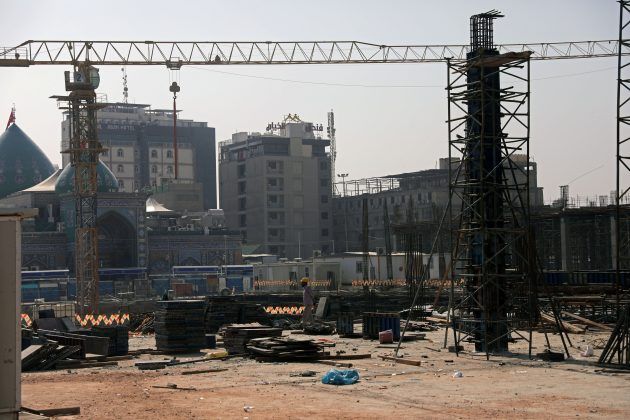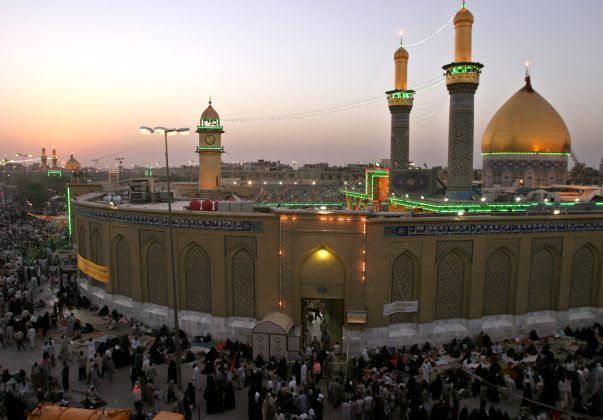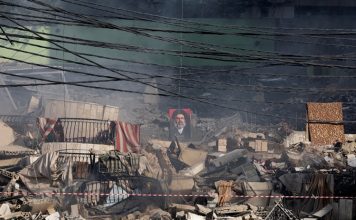By John Davison
KERBALA, Iraq, Dec 2 (Reuters) – In September, a senior Iranian commander made an unannounced visit to one of Shi’ite Islam’s holiest sites in the southern Iraqi city of Kerbala.
Hassan Pelarak, a top officer in the Revolutionary Guards’ elite Quds Force, had recently been sanctioned by the U.S. for weapons smuggling. He was checking in on a construction project led by a firm he owns together with other Revolutionary Guards, a foundation linked to Iran‘s Supreme Leader. This foundation too is under U.S. sanctions.
The vast, $600 million expansion at the Imam Hussein shrine, which is revered as the place of martyrdom of the Prophet Mohammed’s grandson, will swell the capacity of what is already the world’s largest annual pilgrimage, dwarfing the Hajj to Saudi Arabia’s Mecca. It is the biggest development at the shrine in 300 years.
An Iraqi worker at the site sent Reuters pictures of Pelarak, wearing a hard hat and sporting a blue surgical mask, having his temperature taken before entering. The visit, confirmed by an Iraqi employee of the foundation, was not reported by Iranian or Iraqi media. But his visit was not unusual. Pelarak and other Guards commanders overseeing the project freely drop in, workers say, and are given quick tours by the exclusively Iranian companies and engineers they have contracted to carry out the work.
Qassem Soleimani, the late Quds Force commander who spearheaded Iran‘s military and political strategy across the region, was filmed touring the project in 2018, 18 months before he was killed by a U.S. drone strike. His successor, Esmail Ghaani, made an unannounced visit to the shrine two weeks after Pelarak, said an Iranian source in Kerbala.
Day and night, Iranian labourers fill in a 40-metre deep, 50,000-square-metre crater next to the shrine with steel girders and cement brought from Iran. The multi-storey buildings they are erecting will contain ablution stations, a museum and a library. Millions of predominantly Shi’ite pilgrims from across the Islamic world will access the Hussein shrine via a large road tunnel.
It is one of the largest of the multi-million dollar projects that the Revolutionary Guards-owned Kawthar foundation (Kowsar in Persian) is leading to develop religious tourism in Iraq and Syria – with more in the pipeline.
For this report, Reuters paid five visits to the Kerbala project site, examined public information from the shrines and companies and interviewed at least 20 Iraqi and Iranian workers, engineers, businessmen, religious and political officials. The examination reveals how Iran‘s close involvement in religious tourism is bringing Tehran soft power and cementing a presence in Iraqi religious centres that are the nexus of Shi’ite regional influence.
Control of shrine development also deepens trade ties and is a target of potential economic opportunity for Iran: Religious tourism is worth billions of dollars a year in Iraq, the second-largest earner of revenue for the country after the oil sector.
“Iran has long penetrated the Iraqi deep state,” said Bangen Rekani, a former Iraqi housing minister with knowledge of the projects. Increasingly, he said, “Iranians use their soft power and religious ties, which can be more important than political ties.”
Iraq’s government grants religious projects special privileges, including tax exemptions on imports of Iranian cement, steel and other materials. According to multiple sources, many of these goods are brought into Iraq ostensibly for shrine development but are then sold elsewhere in the country. Reuters couldn’t determine the extent of this trade, which helps counter Western sanctions on Iran.
The development of Shi’ite shrines is being spearheaded by Iran‘s Holy Shrines Reconstruction Headquarters, a body set up by Supreme Leader Ayatollah Ali Khamenei and run by the Revolutionary Guards’ appointees. In March, Washington sanctioned the Headquarters and Kawthar, its Iraq-based engineering wing. Pelarak was among officials targeted. The Americans alleged the Headquarters and Kawthar were involved in “lethal aid” to proxy militias in Iraq and Syria, intelligence activities and money laundering. A Treasury spokesperson told Reuters that Iran sought to expand its influence and exploit Iraqi financial and business sectors.
Khamenei has condemned U.S. sanctions as an attempt to destroy Iran‘s economy and overthrow its ruling system. Reuters sought comment for this article from the Iranian government, the Revolutionary Guard, its engineering wing Kawthar and Pelarak, but didn’t receive a response. An Iraqi government official said he couldn’t comment about Kawthar’s activities in Iraq because he didn’t have details, a remark echoed by a spokesperson for the Iraqi state body that administers religious sites.
A spokesman for the Hussein shrine, Afdhal al-Shami, told Reuters that Iran‘s involvement was needed because “Iraq’s economy is such that we can’t undertake a project like this on our own.”
“Iranians love the shrines. When this money comes in from Iranian donors, through an official body, that’s a psychological boost and good publicity at home and abroad for the Iranian government,” he said in an interview.
“DOWN TO THE MIRRORS, IT’S ALL IRANIAN”
Iran built power in Iraq after the 2003 U.S. invasion that toppled Sunni dictator Saddam Hussein and brought rule by Iraq’s Shi’ite majority, especially parties supported by Tehran. The Revolutionary Guards grew a military-business empire in Iran, then expanded their influence across Iraq, Syria and Lebanon. They created a corridor to support militia allies across the region and dominate land borders, overground trade, and expand their presence at Shi’ite holy places.
But now the Islamic Republic’s attempts to expand influence in Iraq are facing new challenges. Iran is distracted by the coronavirus pandemic at home and dissent against the political parties and militant groups it backs in Iraq and Lebanon. Iraq’s top Shi’ite cleric, Grand Ayatollah Ali al-Sistani, has supported calls for political reform and long opposed foreign interference, including that of Iran. The United States and its allies are trying to roll back Iranian influence with sanctions, assassinations of military commanders and a new alliance between Israel, the United Arab Emirates and Bahrain. For the first time in years, an Iraqi government, led by Prime Minister Mustafa al-Kadhimi, has sided with the United States. Kadhimi’s appointment was opposed by Iran-aligned militia groups.
Pelarak’s September visit to Kerbala was the latest sign that despite U.S. pressure on the Revolutionary Guards’ activities in Iraq, the Guards press on with Kawthar’s work.
The U.S. Treasury’s sanctions in March said Kawthar “served as a base for Iranian intelligence activities in Iraq, including the shipment of weapons and ammunition to Iranian-backed terrorist militia groups.” An Iraqi customs official told Reuters Iran did not need Kawthar, an organisation focused on trade and soft power, to transfer weapons. “There are other ways of doing that – their proxy militias control the borders from the Kurdish north to the south of Iraq,” he said.
Kawthar carries out shrine development on behalf of the Holy Shrines Reconstruction Headquarters using a number of specialised Iranian companies. Kawthar is owned by Pelarak and at least two other Guards-linked officials, including a Quds Force commander based in the southern Iraqi holy city of Najaf, according to the U.S. Treasury.
Iraqi traders and officials described how during Iran‘s economic downturn Kawthar has become more important because of its grip on development of religious sites.
“Iran had its eye on shrines since the fall of the (Iraqi) regime in 2003,” said Dhiaa al-Asadi, a former lawmaker close to Najaf-born Shi’ite cleric Moqtada al-Sadr.
The Hussein shrine, visited by up to 50 million pilgrims each year, is housed within a vast, golden-domed mosque decorated with ornate entrances, wooden gates and glass – all from Iran, according to former Iraqi housing minister Rekani and several other government sources. “Down to the mirrors in the shrines, it’s all Iranian,” Rekani said.
The faithful eat for free in adjoined dining halls and pray on carpets while drilling and other sounds of upkeep punctuate an otherwise quiet reverence.
A Reuters reporter visited a Kerbala hotel leased out by the Hussein shrine to host engineers working on the project. The hotel lies on a secured street monitored by cameras. In the reception, a calligraphic sign commemorates the assassinated Soleimani. Engineers dropped by reception on their break to collect packed lunches of rice, chicken and barberries, typical Persian fare. Iranian workers occupy two more hotels in the city and temporary cabins next to Kawthar’s nondescript offices, which overlook the shrine expansion project.
There, Iranian workers wearing the overalls of the companies contracted by Kawthar toil next to health and safety signs in Persian. The engineers in hard hats are often graduates of Shahid Beheshti University in Tehran, according to an Iraqi contractor working with Kawthar. The university is on Western sanctions lists for alleged involvement in nuclear weapons research. Iran‘s science minister has said its activities have nothing to do with atomic weapons research.
The construction site, half empty about a year ago, has quickly been filled with the skeletons of buildings. Pelarak signed a nearly $650 million contract in 2015 with the Hussein shrine for Kawthar to build the extension, named the Sahn al-Aqila Zeinab, the Courtyard of Zeinab, Hussein’s sister.
The Headquarters lists at least 17 projects it is overseeing at important shrines in Najaf, Kerbala, Baghdad and the northern city of Samarra. These contracts are often years-long and worth hundreds of millions of dollars.
In Najaf, Kawthar and the Headquarters have repaired the Imam Ali shrine’s golden dome and facade, and are carrying out a $500 million infrastructure expansion there too. In Baghdad, they have built ornate windows at the shrines of two Shi’ite imams and have been repairing a minaret that is leaning because of swelling groundwater, according to a shrine official. The Headquarters is also working on an expansion of the al-Askari shrine in Samarra. This shrine was bombed by Sunni extremists in 2006, setting off some of Iraq’s most violent sectarian bloodshed.
Pelarak is eyeing more work. He told Iranian semi-official news agency Fars in August he hoped to carry out an expansion at another site in Kerbala, the Imam Abbas shrine, part of a plan “agreed by Iraq’s housing ministry” but not yet requested by the shrine. A spokesman for Iraq’s housing ministry said he couldn’t comment because, “there is no accurate information available on this.” The shrine didn’t comment.
Several Iranian firms carry out the work, serving as contractors. A tunnel, foundation and water specialist called Abtaban is working on the Kerbala project, according to the Revolutionary Guards-linked Tasnim news agency. Padideh, a civil engineering contractor, and Mana, a construction firm, are involved in both the Kerbala project and the development of the Imam Ali shrine in Najaf, according to Iranian news and company websites. Padideh says on its website it is aiming to increase its work in the region.
Reuters found no link between these companies and the Guards beyond the contracts with Guards-run organisations, and the firms are not under U.S. sanctions. The companies did not respond to requests for comment.
An Iraqi government official said Kawthar’s activities and finances are not shared with any Iraqi government departments.
A spokesman for the Iraqi state body that administers Shi’ite religious sites said: “We can’t discuss any topics related to the work of Iranian companies because we do not intervene or have specific details on their activities. They work in holy cities but other than that we don’t know anything.”
Shami, the spokesman for the Hussein shrine, said “if Kawthar has other activities, we don’t know about this.” He said he was also unaware of U.S. sanctions against Kawthar.
SPECIAL STATUS
The Iraqi state funds the initial buying up of private and public land at the sites through budget allocations to Shi’ite religious authorities which make the purchase, said Rekani, the former housing minister.
For the Sahn al-Aqila, part of the Kerbala project, religious authorities paid some $170 million to buy at least 300 properties, according to shrine officials. The Hussein and adjacent Abbas shrines plan to take over more land nearby, the officials said.
Mohammed Musawi, who used to live where the Sahn al-Aqila is being built and owned two hotels there, said the demolition of his properties brought a handsome fee but erased his business and a generations-old family property.
“I didn’t want to sell the house, but when the shrine decides to expand, there’s nothing you can do,” he said. “People receive a lot of money to sell, and if they refuse are given a court order.”
The shrine paid Musawi and his six siblings nearly $1 million for their property. He now runs a corner shop and relies heavily on the pilgrimage business.
After land acquisition, shrine projects are then fully funded by Iran – ostensibly from donations by devout Iranian Shi’ites and through charities linked to Shi’ite shrine organisations, officials at the Hussein shrine said. An Iranian employee of Kawthar, who declined to be named, said much of the money came from Iranian state coffers, but he didn’t know what proportion. A project costing in excess of $600 million “can’t just come from donations, you need a state behind that,” he reasoned. Other Iranian and Iraqi sources supported this view.
Shrine projects get special status under Iraqi law, meaning they are overseen by the shrine organisations, not by the state. There are customs exemptions for all materials coming from Iran for religious, donor-funded projects.
An engineering official at the Hussein shrine declined to say how much steel, cement, wood and other imports are brought from Iran for the project. An Iraqi trader who has worked with Kawthar said large quantities of Iranian steel and cement are imported tax-free under the guise of shrine projects, but then sold via middlemen onto the Iraqi market, where prices are higher than in Iran. A senior Iraqi official with direct knowledge said firms involved in shrine projects “often order several times the required amount” of building materials.
Shami, the Hussein shrine spokesman, maintained that it would be difficult to siphon off goods in this way because they are inspected by Iranian and Iraqi customs officials then transferred straight to the shrine’s warehouses. He didn’t rule out the possibility that some imports had forged shrine documentation, however. “Everything is possible in Iraq,” he said.
The firms have had their workers bussed in from Iran even when the borders are closed, as during the first wave of the COVID-19 pandemic. One Iranian employee of Kawthar told Reuters that when the borders first closed there were problems getting into Iraq, “but the Hussein shrine intervened to get exemptions.” He estimated there were around 200 Iranian workers currently, down from 2,000 earlier.
Shami said he didn’t know if the shrine had sought travel exemptions for Iranian workers.
The Iraqi customs official and an Iraqi contractor said Kawthar is also involved in other infrastructure projects, including energy. Among these projects, according to the contractor, is a power plant in Basra. The power plant project was led by an Iranian energy company called Mapna, which has also been sanctioned by the United States. Mapna is building power plants in Najaf and Baghdad, as well as one of Kerbala’s largest hotels, a Reuters review of official filings found. Mapna didn’t respond to a request for comment.
A LONG GAME
Workers in Kerbala say they see evidence that U.S. sanctions are hurting Iran, and Kawthar. The Iranian Kawthar employee told Reuters he used to take home $1,100 a month, paid in the stable Iraqi dinar, but since the sanctions kicked in, he gets only around $200 because he is now paid in the weak Iranian rial. Work on the site for local Iraqis has all but dried up. An unemployed Iraqi engineering graduate, who used to get regular labour at the shrine, told Reuters he now spends his days hoping for work. He struggles to support a young family.
For the Islamic Republic, its involvement in Iraq’s Shi’ite shrines is a long game. It brings an enduring presence in Shi’ite centres of power, where Iran hopes to influence the succession of Iraq’s most powerful Shi’ite cleric, Sistani. The Guards are regularly in Najaf, where Sistani is based. Sistani’s office didn’t respond to a request for comment.
Sistani’s edicts sent Shi’ite Iraqis to the polls for the first time in their lives in 2005, created an amalgam of Shi’ite paramilitaries to fight Islamic State in 2014, and toppled an Iraqi government last year. Sistani stands against Iranian and other foreign interference in Iraq, and opposes the theocratic model of rule by Khamenei. The Iranian pick to succeed the 90-year-old Sistani died in 2018 in a setback to the Islamic Republic’s plans for Iraq.
Though Iranian influence is resented by large sections of Iraq’s Shi’ite population, religious ties run deep. At the Hussein shrine, bullet holes from where Saddam’s soldiers gunned down Shi’ite rebels in 1991 are framed. At the time, Iran was a haven for Shi’ite opposition to Saddam, a Sunni.
The pilgrimage to commemorate Hussein, slain in battle in 680, is closely associated with the martyrdom of today. Next to images of Hussein on Iraqi highways are posters of Shi’ite militiamen killed fighting Islamic State, which counted Shi’ite Muslims among its most bitter enemies and considered them heretics. Next to them are pictures of Abu Mahdi al-Muhandis, the godfather of those militia groups, killed alongside Soleimani by America.
Abu Mahdi and Soleimani featured this year on a banner at one stall next to the Hussein shrine offering pilgrims free tea and juice, run by Kawthar employees. Just next to the stall were the flags of Iraq’s Popular Mobilisation Forces, the state paramilitary grouping dominated by Iran-aligned fighters. At Baghdad’s Kadhimiya shrine, one donation box is for the Forces.
Iran uses its presence to project regional strength to Sunni Muslim rival Saudi Arabia and bolster its legitimacy at home as a defender of Shi’ite holy places, said Iraqi officials and Iran experts. Saudi officials did not comment for this article.
“Iran wants economic, religious and political influence. The best place to do that is Kerbala and Najaf,” said Mohammed Sahib al-Daraji, a lawmaker on Iraq’s finance committee. “Iran is weakened, but it’s stronger than America in Iraq.”
Ordinary Iraqis say they find themselves once more in the middle of the contest between Iran and America. The Iraqi engineering graduate, who looks older than his 30 years and wears a frayed baseball cap, resents that the only work he’s ever found in his hometown is run by the Revolutionary Guards. But he also resents that when U.S. sanctions kicked in, that work began to dry up.
He spends most days looking for menial jobs. When he’s bored, he borrows for his bus fare and travels to Baghdad with other out-of-work engineers to hold protests demanding jobs and railing against Iraq’s ruling elite – and Iran.
“I’m now working a few days here and there on the shrine project, whenever I can get it,” the worker said. “They’ve reduced my pay by half. But I’ll work for the Iranians if it puts bread on the table – what else is there?”
(Reporting by John Davison; additional reporting by Ahmed Rasheed and colleagues in Baghdad, Parisa Hafezi in Dubai and Bozorgmehr Sharafedin in London; editing by Janet McBride)









